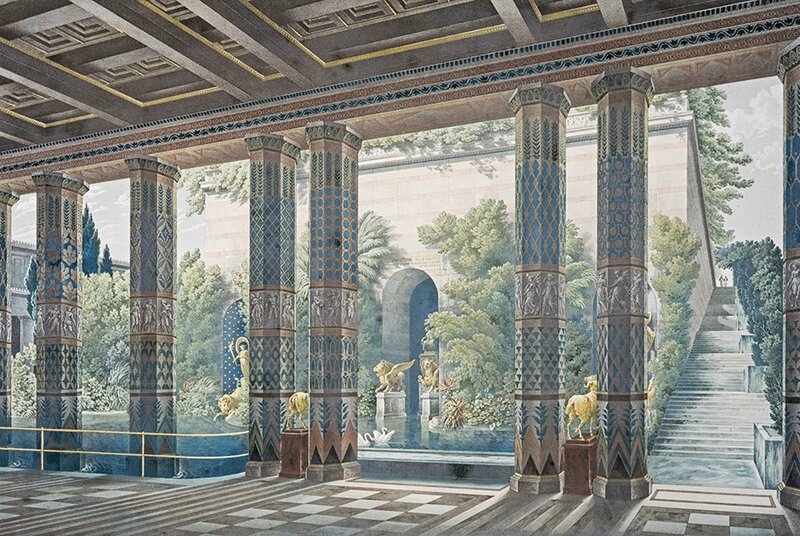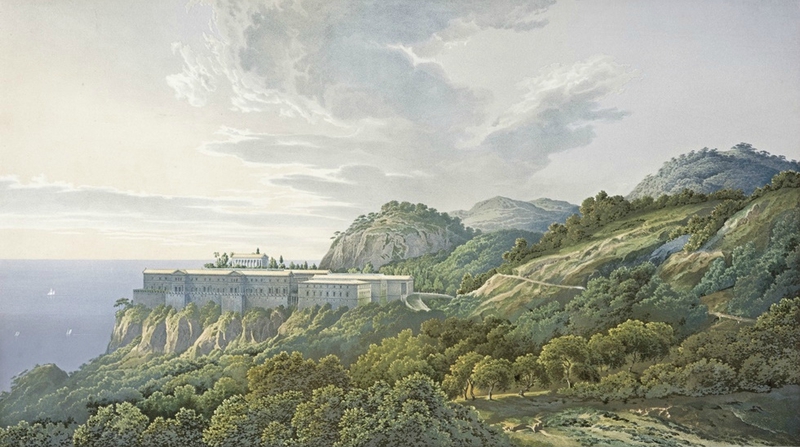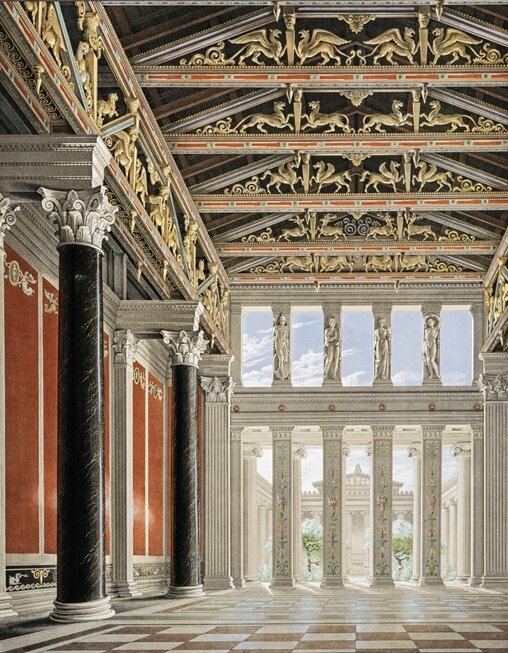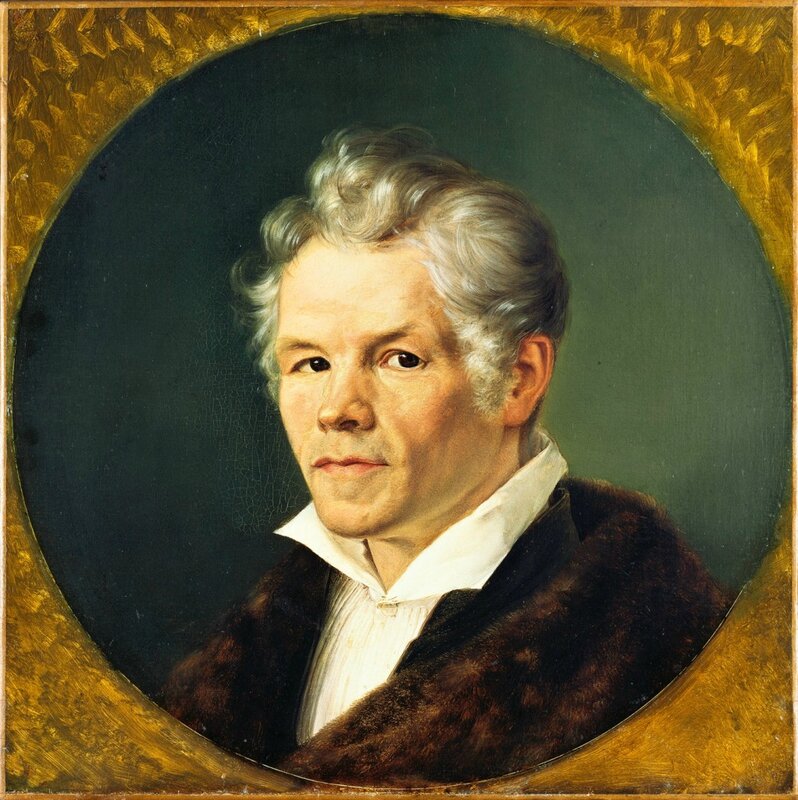Rare 19th c. prints by outstanding German artist go on display at the Scottish National Gallery
W. Loeillot; after Karl Friedrich Schinkel, Crimean Museum, Beneath the Temple Pavillion in the Centre of the Palace Complex, Viewed Looking Towards the Grand Pool in the Imperial Garden Court, published 1848. Colour lithograph on paper. Scottish National Gallery. Purchased with support by the National Lottery through the Heritage Lottery Fund 1997.
EDINBURGH.- Rare prints by the outstanding German architect and artist Karl Friedrich Schinkel (1781-1841) are on public display for the first time in nearly 20 years at the Scottish National Gallery this month. Visionary Palaces: Designs by Karl Friedrich Schinkel will showcase Schinkel’s grand but unrealised designs for two lavish palaces.
Schinkel was one of the most brilliant, accomplished and versatile artistic figures of his generation. In addition to being a celebrated architect, whose grand buildings transformed early nineteenth-century Berlin, he was an exceptional painter and draughtsman, and also designed interiors, furniture and stage sets.
Through a series of extraordinary colour lithographs which were published in the 1840s, Visionary Palaces explores two of Schinkel’s last and arguably most spectacular projects: his ambitious architectural designs for two utopian royal palaces, on the landmark site of the Acropolis in Athens, and at Orianda on the Crimean coast.
Five remarkable, large-scale designs lithographs illustrate Schinkel’s vision for a palace on the Acropolis, which was commissioned for King Otto von Wittelsbach of Greece. The lithographs designs show how Schinkel intended to transform the hilltop archaeological site into a vital part of the living city, by integrating an extensive classical villa suitable for the King’s court with existing monuments such as the Parthenon. Schinkel’s extraordinarily detailed and technically innovative scheme would include a fantastic colossal bronze statue of the goddess Athena towering over the complex, intricately planned landscaping and jaw-dropping interiors. In one of the prints, a dazzling perspective view of the entire complex reveals the prominent height of the site and demonstrates how Schinkel’s design splendidly fits within this unique setting.
Eight of the prints on show illustrate a palace which Schinkel proposed for a location at Orianda, in the Crimea. The splendid cliff-top complex, interwoven with luscious gardens and elegant water-features, was commissioned for the Russian Tsarina, Alexandra Feodorovna, wife of Tsar Nicholas I, who was reportedly fascinated by the rugged coastline and spectacular views of the Black Sea site. The images demonstrate how Schinkel’s palace, perched on its rocky precipice overlooking the coastline, merges into the stunning landscape.
Due to the cost and ambition of the plans neither palace was built, remaining, in Schinkel’s own words, “nothing more than a beautiful dream”. The Scottish National Gallery acquired these extremely rare lithographs (one of only three known sets of their kind in the UK) in 1997, with the support of a generous grant from the Heritage Lottery Fund. Although the projects never became reality, these beautiful prints remain a powerful testament to Schinkel’s unique and expansive vision.
Michael Clarke, Director of the Scottish National Gallery, commented: “Schinkel’s genius is best appreciated in his surviving buildings in Berlin, but he did visit Edinburgh in 1826 on a fact-finding tour of Britain. His interest then centred on industrial architecture (a newly constructed gasworks in Canonmills). I hope he would appreciate our present-day fascination with his later, and much more glamorous, ‘Visionary Palaces’!“.
When the Schinkel prints were shown at the Scottish National Gallery in 1998, the National Galleries of Scotland’s skilled technicians designed and constructed a number of bespoke ornate frames, based upon existing period examples and made using largely traditional methods. To complement the Visionary Palaces exhibition there will be a small display relating to the creation of these frames.
Heinrich Mutzel; after Karl Friedrich Schinkel, Perspective View of the Grand Pool to the North of the Imperial Garden Court, Looking Towards the Podium Housing the Crimean Museum, published 1846. Colour lithograph on paper. Scottish National Gallery. Purchased with support by the National Lottery through the Heritage Lottery Fund 1997.
Karl Schnechten; after Karl Friedrich Schinkel, Perspective of the Principal View of the Royal Palace on the Acropolis: Section Through Line A.B. on the Ground Plan Looking West. From Palaces, a set of prints of the Palace on the Akropolis in Athens and the Orianda Palace in the Crimea. Colour lithograph on paper. Scottish National Gallery.
Heinrich Mutzel; after Karl Friedrich Schinkel, Perspective of the Palace Complex in its Landscape Setting, Viewed from Inland. From Palaces, a set of prints of the Palace on the Akropolis in Athens, and the Orianda Palace in the Crimea. Colour lithograph on paper. Scottish National Gallery.
Heinrich Asmus; after Karl Friedrich Schinkel, Interior Perspective of the Great Hall, Looking Towards the Garden Court. From Palaces, a set of prints of the Palace on the Akropolis, Athens, and the Orianda Palace in the Crimea. Colour lithograph on paper. Scottish National Gallery.
W. Loeillot; after Karl Friedrich Schinkel, Perspective View of the Sea Terrace, Showing the Caryatid Portico and Glazed Semi-circular Side Bay. Published 1847. Colour lithograph on paper. Scottish National Gallery. Purchased with support by the National Lottery through the Heritage Lottery Fund 1997
Carl Friedrich Ludwig Schmid, Karl Friedrich Schinkel, 1832, Oil on canvas, 48 × 48 cm, Nationalgalerie, Staatliche Museen zu Berlin, © Nationalgalerie, Staatliche Museen zu Berlin / bpk

/https%3A%2F%2Fprofilepics.canalblog.com%2Fprofilepics%2F1%2F0%2F100183.jpg)
/https%3A%2F%2Fstorage.canalblog.com%2F03%2F02%2F119589%2F96711876_o.jpg)
/https%3A%2F%2Fstorage.canalblog.com%2F11%2F31%2F119589%2F94773502_o.jpg)
/https%3A%2F%2Fstorage.canalblog.com%2F20%2F83%2F119589%2F94772815_o.jpg)
/https%3A%2F%2Fstorage.canalblog.com%2F26%2F72%2F119589%2F75604929_o.jpg)
/https%3A%2F%2Fstorage.canalblog.com%2F59%2F60%2F119589%2F26458628_o.jpg)









/http%3A%2F%2Fstorage.canalblog.com%2F13%2F35%2F119589%2F112598146_o.jpg)
/http%3A%2F%2Fstorage.canalblog.com%2F30%2F17%2F119589%2F112590944_o.jpg)
/http%3A%2F%2Fstorage.canalblog.com%2F56%2F05%2F119589%2F109831882_o.jpg)
/image%2F1371349%2F20240426%2Fob_dcd32f_telechargement-32.jpg)